The most effective measures to combat bud mite on currants in spring
To get a good harvest of black or red currants, it is recommended to follow a number of agrotechnical rules. One of them is spring treatment against bud mites. The pest lives on the plant all year round, but becomes more active after winter, when warm weather sets in. Kidney mites live in groups; in one kidney there are sometimes up to 8,000 individuals sucking juices. Let us consider in detail what the pest is and what methods of combating it are used.
What kind of pest is this
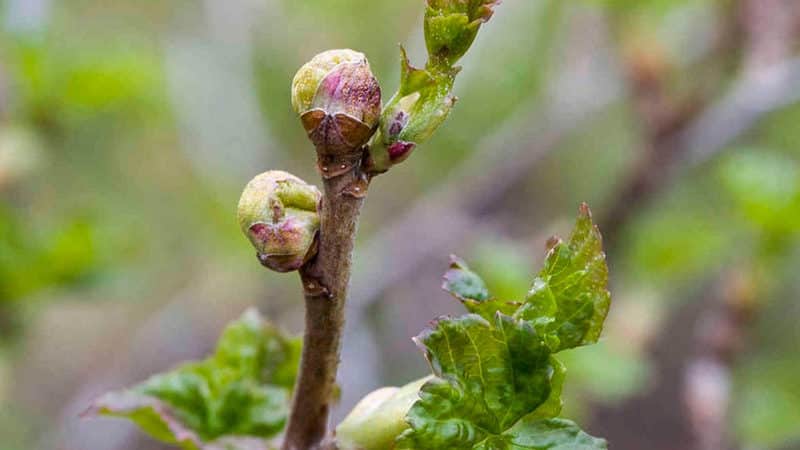
The kidney mite is a small, thin insect with a body only 2 mm long. The color is light beige, the shape is worm-shaped. It is difficult to see mites with the naked eye: they always hide inside currant buds. Therefore, with the arrival of spring, it is recommended to regularly inspect the bushes. It is advisable for novice gardeners to study photographs of the pest.
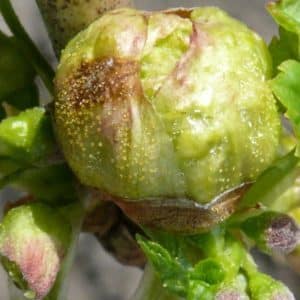
The main sign of damage is a deformed and withered bud. It swells and bursts, and over time it either dries out completely or produces diseased shoots. Once the mites are done with one bud, they go in search of another. Pests are carried by wind, rain, insects, animals, and rodents.
The bud mite is dangerous because the affected shrubs slow down or even stop growing, which is why the yield suffers. Outwardly, such currants look sick, so even as a hedge, they look bad.
Advantages and disadvantages of spring measures to combat bud mites
The advantages include the opportunity to carry out prevention. However, the vital activity of the bud mite depends little on the time of year, so it is easy to miss the moment when the buds swell and burst. This happens if the mite overwintered on the plant and became more active with the arrival of spring. Here spring treatment cannot be avoided, the destruction of the pest must take place throughout the year, including summer and autumn agricultural activities.
Attention! Sometimes gardeners try so hard to get rid of bud mites that they forget about other nuances of plant care. For example, with the arrival of spring, it is not recommended to immediately use strong chemicals; it is better to choose biological or folk remedies. Otherwise, the weak plant will not withstand the chemicals, which will negatively affect the yield.
During the period of mass reproduction of the bud mite, it is forbidden to use strong chemicals - currants bloom wildly and berries are set. Chemicals pose a threat to pollinating insects.
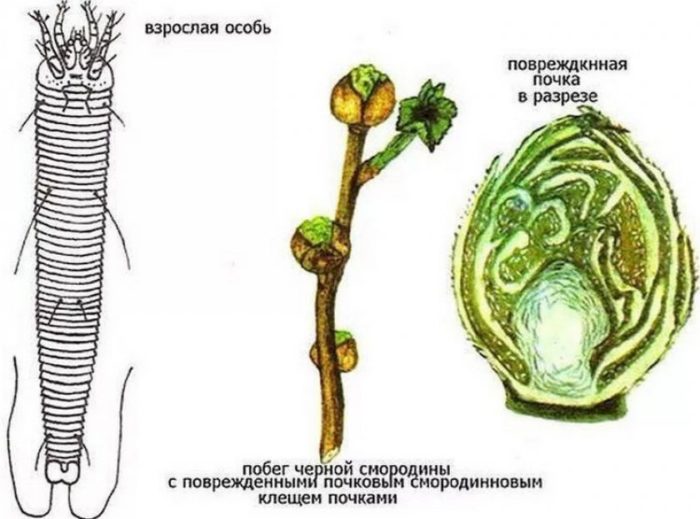
How to deal with pests in spring
What measures exist to combat kidney mites? on currants in spring? There are many of them: agrotechnical, mechanical, biological, folk. Each method has its own advantages and disadvantages. Let's look at how to cure currants.
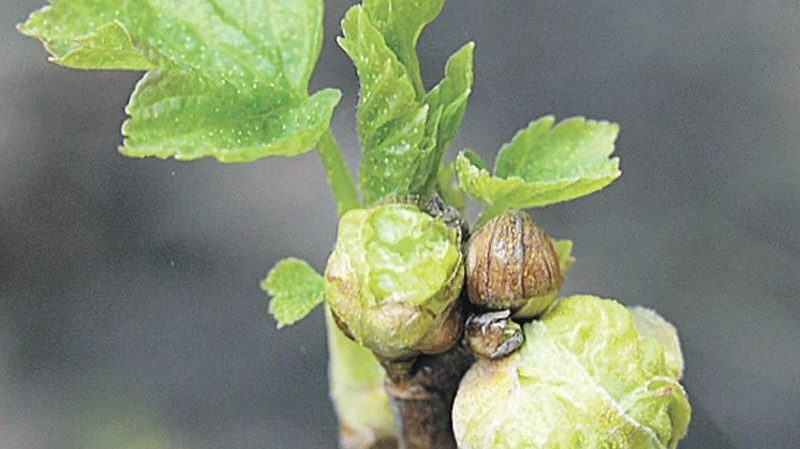
Mechanically
The mechanical control method involves inspecting the bushes and collecting affected buds by hand. If there are several affected buds on a branch, it is recommended to cut it off completely and burn it away from the garden plot. Before collecting kidneys bushes are watered with boiling water. After the water boils, it is poured into a watering can.Recommended water temperature is +45°C.
This simple procedure allows you to get rid of other larvae. insect pests: spider mites, leaf rollers, aphids, moths. Collect kidneys while wearing gloves.
Attention! The mechanical method does not completely rid the bush of insects.
Chemicals
Chemicals are used before flowering. It is important to remember that only drugs of the first and second classes of danger, that is, highly toxic, get rid of the pest. Therefore, when using them, follow safety rules: carry out spraying wearing a protective suit and gloves, a respirator and goggles. During treatment, children and pregnant women, as well as animals, should not be nearby. It is forbidden to eat and drink. Gardeners use:
- The drug "Envidor". It destroys all types of mites on indoor and garden plants. Use the product in May or no more than 20 days before harvesting. Prepare a solution and treat the leaves with it on both sides. For 5 liters of water, 2-3 ml of the drug is required, no more than 2 treatments are allowed. The waiting period for the drug to take effect does not exceed 20 days.
- Aliot remedy has a triple effect: contact, intestinal and partially fumigation. To prepare the working solution, 10 liters of water and 10 ml of the drug are required; from 0.5 liters to 1 liter are consumed per bush. The plant is treated at least 3 weeks before harvest. No more than 2 treatments are carried out per season. "Aliot" guarantees the death of pests within 2 hours.
- "Phosfamide" penetrates the plant through the root system and is effective for 15–25 days from the date of treatment. It fights not only against bud mites, but also against caterpillars, scale insects, aphids, and leaf rollers. The waiting period for the drug to take effect is about 12 days.
Agrotechnical techniques
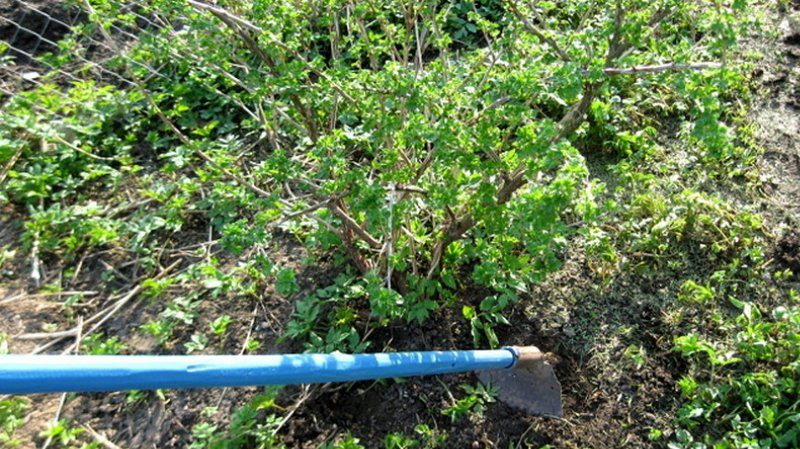
Bud mites use weeds for feeding and reproduction, so it is recommended to remove them regularly. Digging helps fight perennial weeds (thistle, dandelion), and collecting grass by hand helps fight annuals.
Reference. Experienced summer residents plant green manure, such as mustard, next to currants and other berry bushes. It protects currants from pests and diseases. In autumn, green manure is used as a natural fertilizer.
Another agricultural technique - pruning old branches. It is carried out for preventive purposes. Remove the branches that grow in the center of the bush and those that intertwine with each other. They no longer bear fruit, so there is no point in leaving them. Young stems are shortened by 15 cm to stimulate the growth of bushes and increase yield.
It is recommended to maintain a row spacing of at least 1.5 m. Otherwise, dense planting will lead to the rapid spread of pests. Mown grass or hay is laid out between the rows, and the base of the bush is mulched with sawdust or sand. The mulch layer should not be less than 5 cm, otherwise the weeds will grow to the top. It is advisable to pull out weeds by the roots rather than cut them down with a hoe.
Biological products
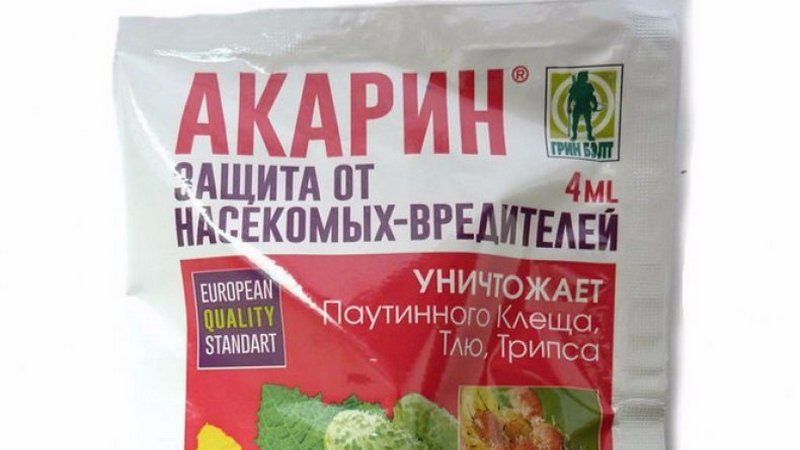
Biological preparations are less toxic and aggressive than chemicals, therefore they are most popular among summer residents. To combat kidney mites, use a product "Akarin." It begins to act 4–8 hours after treatment. Apply before flowering. The leaves are not doused, but only slightly moistened. To treat currants, dilute 3 ml of the drug in 1 liter of water; about 1 liter of product is needed per bush. "Akarin" is compatible with growth stimulants and other biological drugs.It is important to remember that the prepared working solution is not suitable for long-term storage. Therefore, before cooking, calculate the required amount of liquid.
Attention! Biological products “Kontos”, “Forbid”, “Fitoverm”, “Bikol” are used against the kidney mite.
The biological product is effective "Boverin". It acts against insects that live in the soil and on the surface of the plant. The product is applied at the end of April or beginning of May into moist soil. For 10 liters of water, 400 ml of the drug is required. Treatment is carried out once every 7–14 days, but no more than 2 times per season. It is not recommended to add complex minerals to the soil at the same time as Boverin. fertilizers. The drug is safe for people and animals, but we must not forget about precautions.
Folk remedies
Folk remedies are used for protective purposes, so if the mite has already appeared on the currant, it is better to use chemical or biological preparations. Garlic agent is used for processing: 200 g of peeled garlic is added to a bucket of water. Leave the infusion for 2-3 hours, filter and begin processing. If you don't have garlic on hand, onion skins will do.
Mustard infusion is also used for prevention. For 5 liters of water, 200 g of dry mustard is required. The solution is stirred, covered with plastic wrap and left for 12 hours. Strain and process currant bushes in the morning or evening.
What to do if there are green worms in currant berries
If green worms are detected in the berries, the currants are treated with biological products or chemicals. A proven option is a solution of 10 liters of water, 10 g of sulfur and 75 g of karbofos. The first treatment is carried out before flowering, when the buds enlarge and swell, the second - after 2-3 weeks.The recommended temperature for the procedure is no more than +20°C. Since sulfur is a toxic substance, during the second treatment its amount is reduced to 5 g.
If the leaves are eaten
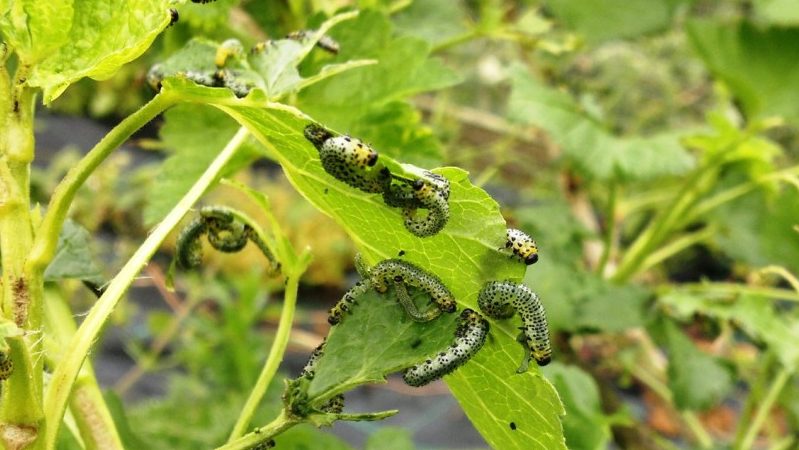
The biological product “Actofit” helps against worms on the leaves. It is environmentally friendly and begins to act in 2-3 hours. Currants are processed in dry and windless weather, in the morning. The leaves are irrigated with the solution on both sides. "Aktofit" can be combined with any mineral and organic fertilizers. The product gets rid of not only green worms and caterpillars, but also sawflies, moths, aphids, moths, and weevils.
Attention! After treatment, it is important to inspect nearby growing crops for the presence of pests. Even if there are no signs of insects, it is recommended to spray the currants with garlic solution or Bordeaux mixture.
Preventive measures
The first preventive measure is to use healthy planting material. Two-year-old seedlings purchased from trusted sellers are planted on the site. The roots are first soaked in hot water, and the soil is treated with a solution of Bordeaux mixture or poured with boiling water to destroy all microbes and larvae. The bushes are placed at a distance of at least 1.5–2 m from each other and from other plants.
in spring currants are pruned and thin out, removing old and diseased shoots. They contribute feeding: The culture reacts well to a solution of mullein, chicken droppings, and ash. Fertilizers strengthen the bush's immunity, which protects against insects. Before agricultural activities, garden tools are disinfected and the rules for preparing solutions are followed.
It is important to regularly monitor the condition of the bushes and inspect the leaves on both sides. If insects are found, immediately treat currants and neighboring crops.
Currant varieties resistant to bud mite
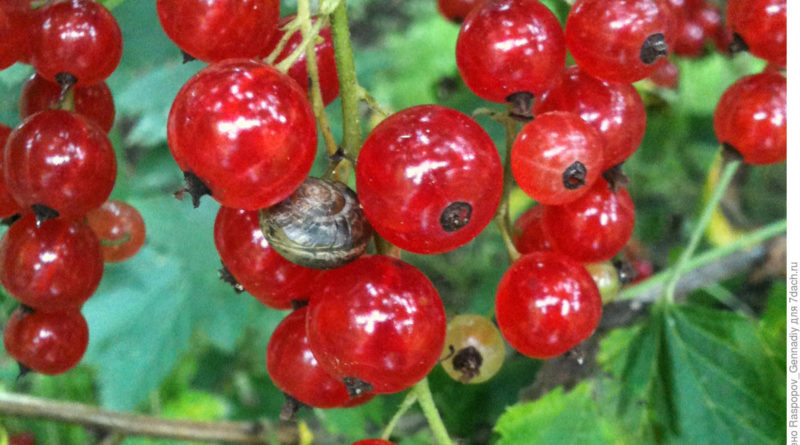
Red currant varieties include Orlovchanka, Uralskie Zori, and Rosita. Shrubs have strong immunity and are rarely affected by diseases and pests, including bud mites. They are grown in the central zone of the country and northern regions.
Of the blackcurrant varieties, gardeners prefer Ksyusha, Aleander, and Voroninskaya. They are characterized by high productivity and resistance to external factors. However, it is important to remember that any currant needs preventive and protective measures.
Conclusion
Has a white worm appeared on the currant? How to get rid of it? To combat kidney mites, chemical or biological preparations are used: “Aktofit”, “Borevin”, “Bikol”. They quickly kill pests and prevent their reappearance. The first treatment is carried out at the end of spring, the second at the beginning of summer. For prevention, use folk remedies (garlic or mustard solution), follow the rules feeding and weeding.